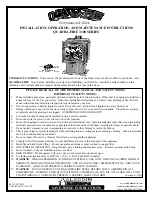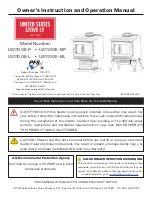
control areas have been "authorised" in Regulations and that appliances used to burn solid fuel in those areas
(other than "authorised" fuels) have been exempted by an Order made and signed by the Secretary of State or
Minister in the devolved administrations.
The
“Ekol Clarity 12”
has been recommended as suitable for use in smoke control areas when burning seasoned
wood.
Further information on the requirements of the Clean Air Act can be found here : http://smokecontrol.defra.gov.uk/
Your local authority is responsible for implementing the Clean Air Act 1993 including designation and supervision
of smoke control areas and you can contact them for details of Clean Air Act requirements
FUEL
Wood- All types of wood are suitable provided they are wells seasoned, UNTREATED, and have a moisture level
between 12% and 20%. For soft woods, typically they will need to have been left in suitable storage for 9+ months
in order for the moisture to evaporate. For hardwoods, this will usually be 18 . It is recommended that logs
should be no more than 5” or 125mm in diameter. If you are unsure of the moisture content of your fuel, then you
can buy a moisture meter which will indicate the moisture levels in your fuel.
Liquid fuels must NEVER be used.
WARNING: Wet timber should not be used as this will create excess tar deposits in the chimney and stove and
could increase the risk of chimney fire. Timber which is not of a suitable moisture content will also create more
smoke and harmful emissions.
Manufactured smokeless coals and anthracite can be used and will all have different qualities and effects.
– Do
NOT use Petro-Coke based fuels or any petroleum based fuels as this will invalidate the warranty. Never use your
stove as incinerator to burn waste or rubbish. Any coal burned should be coal suitable for a multi-fuel stove (some
coal is only for use on open fires and burns too hot for a stove).
Never use your stove as incinerator to burn waste or rubbish.
AIR INLET CONTROLS
Your stove has three air inlet areas-
The upper vent provides air supply for the air-wash system and allow air into the higher areas of the fire box – this
is called the Secondary air – when this vent is open, the door glass is kept clean by high speed air rushing
downwards across the inside of the glass. By moving the Secondary vent knob to the right, airflow into the stove is
increased. The secondary air vent is set such that the closure plate does not seal fully, thus allowing some constant
air supply into the stove.
The lower vent knob on the bottom of the door controls the provision of Primary air – this is the primary source of
air supply for combustion. Sliding the knob to the right increases the amount of Primary airflow into the stove.
The third (Tertiary) vent control is located underneath the stove and controlled by a lever/ knob tucked under the
bottom shelf. Moving the lever forward increases the airflow into the stove. The air is then channelled through a
chamber on the back of the stove and to the rear of the firebox, and enters the firebox via a series of small holes in
the throat plate. Even in the closed position a certain amount of air will still be allowed to enter the stove. This is
legally required to ensure the stove maintains level of combustion not likely to create excessive smoke.
TOOLS
The glove is provided for adjusting the air inlets and for opening the door when the stove is hot, as these knobs will
heat up when in use.
























